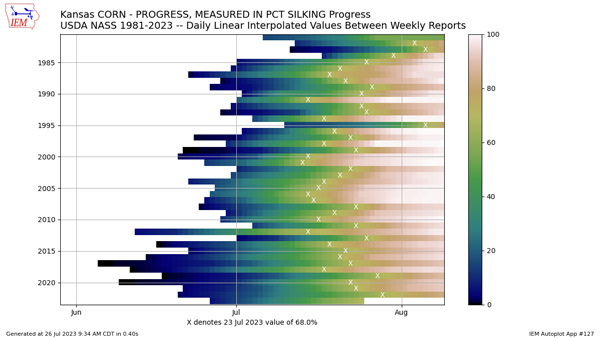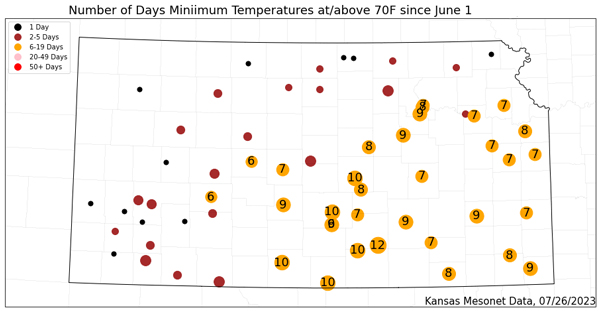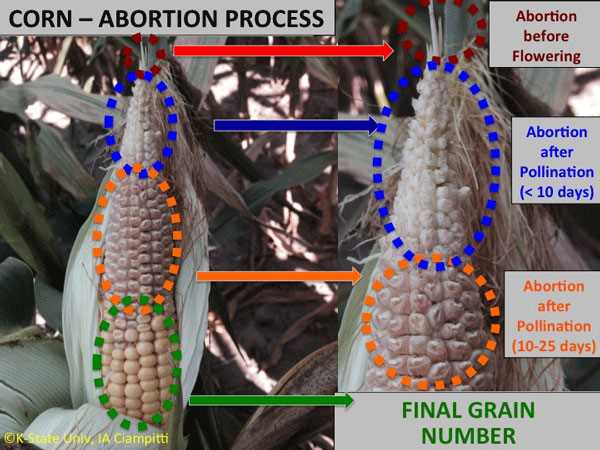Kansas is in the midst of an impressive heat wave and the impacts to agriculture and corn in particular are of concern. According to the USDA National Agricultural Statistics, the percentage of corn reaching silking has increased to 68% as of July 24, 2023, ahead of the average of 59% for the same period (Figure 1).

Figure 1. Kansas's average progress of corn at the silking stage since 1981. Source: NASS/IEM.
July has observed moderate weather conditions with moisture and at/below normal conditions throughout most of the month. However, in the last week, conditions have flipped significantly. The number of 100°F days has greatly increased (and is forecast to continue) with the focus of the most intense heat in Ness City/Jetmore. That area has measured as much as 7-8 days with high temperatures at/exceeding 100°F since June 1 (Figure 2). This is behind last year when some locations had seen 20+ days. Overnight lows have also been above 70°F which would compound the heat stress on corn (Figure 3). Higher humidity in central and eastern Kansas has resulted in fewer days of lows exceeding 70°F than last year. However, central locations have seen up to 10 days of lows greater than that threshold.

Figure 2. Total days with a maximum temperature greater than 100°F since June 1, 2023. Source: Kansas Mesonet

Figure 3. Total days with minimum temperature greater than 70°F since June 1, 2023. Source: Kansas Mesonet
Heat stress will have more of an impact on corn at this stage of growth when combined with drought stress. Even in the absence of drought stress, heat stress alone can still increase the asynchrony (disrupted timing) between pollen shed and silk extrusion when corn reaches flowering time, ultimately reducing the final number of kernels (Figure 4). In addition, if stress conditions are prolonged, those effects will be reflected in a larger kernel abortion and impact the final size and kernel weight, negatively impacting final yields.

Figure 4. Ear abortion in corn from the combined effect of heat and drought stresses at the critical period around flowering. Photo by Ignacio Ciampitti, K-State Research and Extension.
Growing Degree Day tool on Kansas Mesonet
The Kansas Mesonet has a useful tool that tracks growing degree accumulation for multiple crops. With this tool, you can pick the planting/emergence date for the start of the interval. Selecting the graph will illustrate the growing degree accumulation for this season versus normal and the plant stage. You can access the page at: https://mesonet.k-state.edu/agriculture/degreedays/. You can also access the Maximum and Minimum temperature data here: https://mesonet.ksu.edu/weather/maxmin. Mesonet data updates in real-time with data from 79 weather stations.
Grain abortion from heat and drought stress in 2022
The following example depicts the occurrence of grain abortion resulting from a combination of heat and drought stress during various reproductive stages in corn plots at the K-State Agronomy North Farm in 2022 (Figure 5). The picture shows the upper section of the corn ears with several grains aborted. This grain abortion is due to multiple processes, including sterility of flowers, lack of pollination, pollination but lack of effective grain formation, and grain formation but late abortion (after pollination), all mainly due to heat and drought conditions. The failure of pollination is mainly due to an asynchrony between pollen availability for the last silks emerging (from the tip of the ears). However, it also shows pollination failures at the middle and base of the ears, indicating issues with pollen viability due to heat stress (Stress Degree Days totaled around 170-200 around R1).
Besides the heat stress starting right before the VT stage, the crop also started to suffer from drought conditions due to the absence of rainfall during the reproductive stages. This combined stress (both heat and drought) caused additional grain abortion during the R2-R3 stages, even after successful pollination (upper-middle section of the ears). As demonstrated in Figure 4, grain abortion can occur several weeks after pollination, affecting not only grain number but likely the maximum grain weight as well.
Comparing the current season to 2022, we observe that although stress levels are above the average (Figure 5) for corn planted in early May, stress degree days accumulation in 2023 is far below the 2022 season. Therefore, we may expect to see fewer grain abortion issues in 2023.

Figure 5. Corn ears at R4 stage (dough) showing grain abortion at different sections due to heat and water stress at variable moments during reproductive stages, since VT (tasseling). Corn plots were planted at the North Farm (Manhattan, KS) on May-01-2022. Photo source: Ciampitti Lab. Precipitation (PP) and Evapotranspiration (ETo) source: https://mesonet.k-state.edu/weather/historical/. Stress Degree Days source: https://mesonet.k-state.edu/agriculture/degreedays/.
Final considerations
Stress conditions were very severe in parts of central, south central, and southeast Kansas, compromising yields and presenting a large impact on potential productivity. Farmers should scout their fields and perform yield estimates (https://bit.ly/3PJw9JN) and consider making a decision on the crop for the coming weeks. Stay tuned for more information on the effects of stress conditions on corn fields across the state.
Christopher “Chip” Redmond, Kansas Mesonet Manager
Christopherredmond@ksu.edu
Ignacio Ciampitti, Farming Systems
ciampitti@ksu.edu
Adrian Correndo, Postdoctoral Fellow
correndo@ksu.edu
Tags: corn hot weather drought stress heat stress crop development